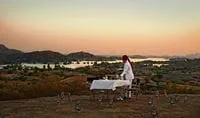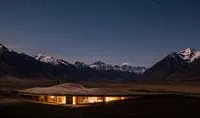Destination guide: Crete
This mountainous island is the largest and most southern of the Greek islands and the fifth-largest in the Mediterranean. Its distinct character and way of life make it more of a separate country, rather than part of Greece. With its abundance of beautiful scenery, stunning beaches, remote traditional villages and variety of attractions, Crete has been seducing visitors for a long time.

Scott Dunn has four fabulous and very different properties in Crete, all based in the northeast of the island. Amirandes is a luxurious and stylish hotel - service doesn’t get much better than this. Beautiful rooms and suites, a great choice of restaurants and a stunning beach side location, make this a fabulous destination. Families with small children find Daios Cove a holiday haven. Our exclusive Scott Dunn Explorers club ensures both parents and little ones have a memorable time. For the more independent travellers, Paradise Island Villas is a perfect base from which to explore the island. And if you’re after some indulgent treatments, the Blue Palace Resort & Spa is a relaxed beach resort with views across to Spinalonga Island.
Attractions
From fabulous beaches to ancient ruins, mountain biking through hillside villages to wine tasting, Crete has enormous variety to offer the visitor. With the island’s famous ancient history, the palaces of Knossos, Phaistos and Agía Triáda and the Archaeological Museum in Heraklion are full of interest and well worth a visit. For people who enjoy being more active, it’s fun to walk part of the Samarian Gorge. It’s the longest in Europe, but you should get there early, if you like peace and quiet. At one point, it measures only about 10ft wide and the cliffs either side soar to nearly 1000ft. Keen (and very fit) cyclists might like to hire a bike and explore some of the island’s hilly trails. If you’re travelling with young children, there are plenty of places to go that they’ll love. The Cretaquarium between Heraklion and Kato Gouves is an exciting marine world full of hundreds of different species. Boat trips can be taken to Spinalonga Island – once a Venetian fortress and later a leper colony. And if you visit Aghios Nikolaos, make sure you go on a Wednesday, when the local market is on. The fresh food on sale is wonderful and the atmosphere is vibrant. Try to get a table at Pelagos for lunch – a fish restaurant surrounded by orange trees, where the service is exceptional. It’s one of our favourites. Elounda, a small but pretty fishing village at the head of the Spinalonga peninsula, with a variety of bars, cafes, restaurants, plus small shops selling local handcrafted gifts, also makes a lovely trip.
Climate
Crete is a perfect holiday destination with more than 300 days of sunshine, and only a very few rainy ones, and those are usually from late October. The island straddles the Mediterranean and North African climatic zones making it mostly temperate. Between May and October, the average temperature is 25°C. During summer time, in the hottest months of July and August, the temperature gets higher and can reach the low 30s. The sea temperature off the beaches can reach 25°C. There can be some strong winds during the high season, but these don’t last very long, and tend to be a bit of a respite from the heat. Late Spring is a lovely time to visit, with everything blossoming and the wild flowers at their best. And many consider September to be an ideal time to visit, as the temperatures are still high and the olive and fruit harvests begin.
Cuisine
Crete is an island for epicureans - the food here is distinctly different from that of mainland Greece and the rest of the Mediterranean. Many studies and much research have centred on the Cretan diet for its life prolonging qualities. Meat is reserved mainly for special occasions, whilst a lot of fish is eaten, more so on the coast, and Cretans have a talent for taking a few good ingredients and doing very little with them. Cheese, grains, fruits and vegetables form the base of the diet here, with lots of herbs and a huge amount of olive oil. More olive oil is consumed in Crete than in any other country in the Mediterranean, including Italy. Things to try are "dakos" a typical rustic dish of Cretan dried bread, mashed tomatoes, olive oil, oregano and crumbled cheese, and "mizithra", a delicious sweet and creamy sheep’s cheese, which is perfect with either salad for dinner, or honey as dessert. Eating in Crete is all about sharing, so you’ll find traditional and delicious meze on most menus. And don’t forget to try some local wines. It’s believed that the ancient Minoans learned viniculture from the Phoenicians, and one of the world’s oldest wine presses – over 3500 years old – was found in Vathipetro. There are many well-established wineries producing very creditable and award-winning wine.
History
Crete has a rich historical and cultural past. It was the centre of Europe’s most ancient civilisations, the Minoan, dating back to 4000BC, and the first to build palaces. The capital of Minoan Crete was Knossos, situated about three miles south of Heraklion, and the excavated ruins can be explored today. Archaeologists have discovered evidence of a remarkably sophisticated people who traded olive oil, cereals and wine. Mythology tells of how King Minos hid his son, the Minotaur – a man/bull hybrid, in a labyrinth in the Palace. The architect Dedalus was also imprisoned there, in case he were to reveal the exit. He escaped with his son Icarus, who, with his wings made from wax, flew too close to the sun and fell to his death in the Aegean. The devastation caused by a large volcanic eruption on Santorini destroyed the Minoan civilisation, and the island fell successively to the Romans, the Byzantines, the Venetians and then the Ottomans, until finally becoming part of Greece. The Allies used Crete as a base at the beginning of the Second World War, but were overthrown by the Germans. Now Crete enjoys its status as a major tourism destination, with visitors coming back year after year.
Why Scott Dunn?
Unique to You

- We listen to your travel goals and craft unique trips that are bespoke to you.
- We’re with you every step of your life’s travel journey, from honeymoons to family trips and beyond.
Seamless Service

- Global offices in the UK, US, and Singapore for 24/7 seamless service.
- We offer flexibility if your plans change so you can book with confidence and peace of mind.
Carefully Curated Collection

- We’ve curated an elevated collection of accommodation, experiences, and guides.
- Committed to fostering close global relationships to continue bringing you unique experiences.
Luxury in Every Sense

- We deliver a sense of luxury that matters most to you.
- Awarded Condé Nast Traveller’s Top Travel Specialists in the World 12 years in a row.

